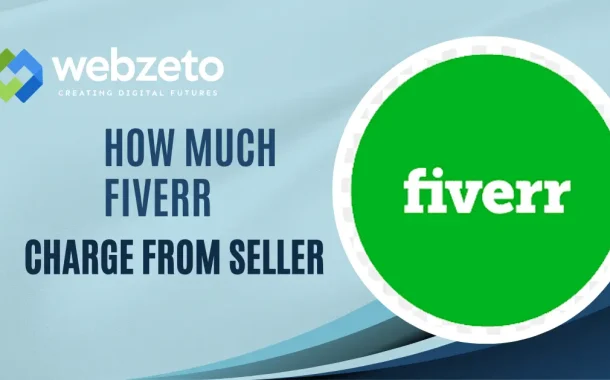For sellers, knowing the fees involved helps in pricing their services effectively to remain competitive while covering costs. It also impacts earnings, as fees can vary based on service categories and additional features. For buyers, understanding these fees ensures transparency in costs and helps in budgeting for projects effectively.
Table of Contents
Table of Contents
Fiverr Fees
Fiverr applies several types of fees that affect both sellers and buyers.
Platform Fees
Fiverr charges sellers a service fee of approximately 20% on each completed transaction. For example, if a seller earns $100 from a gig, Fiverr will deduct $20 as its platform fee. This fee covers the cost of using Fiverr’s platform to connect with clients, get orders from fiverr, and handle customer support. It’s a standard deduction across most service categories on the platform.
Understanding the platform fee is crucial for sellers to calculate their net earnings accurately. It’s important to factor this fee into pricing strategies to ensure profitability while remaining competitive. Sellers can also achieve lower fees by advancing through Fiverr’s seller levels, which offer reduced commission rates for higher-level sellers.
Service Fees
Depending on the service category, sellers may face additional fees. For instance, certain categories like video editing or programming may have different fee structures compared to categories like graphic design or writing. These fees can vary based on the nature of the service offered and any additional features or packages included in the gig.
Sellers should carefully review fee structures within their chosen service categories to understand how they impact overall earnings. Adjusting service offerings or pricing tiers can help optimize earnings while aligning with market demand and competitive pricing on Fiverr.
Payment Processing Fees
Fiverr also deducts fees for processing payments. These fees vary based on the payment method used (e.g., PayPal, credit card). Typically, payment processing fees range from 2% to 5% of the transaction amount. These fees cover the costs associated with securely processing transactions and transferring funds to sellers’ accounts.
Buyers benefit from understanding payment processing fees as they plan project budgets. By choosing payment methods with lower processing fees or bundling payments to minimize transaction frequency, buyers can optimize project costs when hiring freelancers on Fiverr.
Fee Structure for Different Service Categories
Fiverr’s fee structure can vary depending on the specific service category in which sellers offer their services.
Basic Service Categories
Categories such as graphic design, writing, and translation typically have a standard fee structure. Sellers in these categories often face the standard platform fee of approximately 20% per transaction, with additional fees for optional extras or higher-tier service packages.
Understanding these fees helps sellers in basic service categories to set competitive prices while factoring in Fiverr’s commission. By offering clear pricing and value-added services, sellers can attract more clients while optimizing their earnings.
Specialized Service Categories
Categories like video editing, programming, and legal consulting may have different fee structures. These categories often involve higher-value services or specialized skills, which can influence fee percentages or additional charges based on service complexity and market demand.
For sellers in specialized categories, knowing the specific fee structures helps in strategic pricing and service packaging. Sellers may adjust their pricing strategies to reflect their expertise, the complexity of the services provided, and the perceived value by potential clients.
Fee Variations by Seller Level
Fiverr’s seller levels (e.g., New Seller, Level One, Level Two, Top Rated Seller) can also impact fee structures. Higher-level sellers may benefit from reduced commission rates as a reward for their performance and longevity on the platform.
Sellers aiming to advance to higher levels should understand how achieving these milestones can affect their fee structures. Maintaining high-quality service, receiving positive reviews, and meeting performance metrics can contribute to lower fees and increased earnings over time.
Factors Affecting Fee Calculation
Several factors influence how Fiverr calculates fees for sellers on its platform. These factors is crucial for sellers to optimize their pricing strategies and maximize earnings.
- Service Category: The category of service offered plays a significant role in fee calculation. Different categories may have varying fee structures based on the nature of the service and market demand. For example, highly specialized categories like programming or legal services may incur higher fees compared to more general categories like graphic design or writing.
- Gig Pricing: The price set for each gig impacts fee calculation. Fiverr’s platform fee of approximately 20% is applied to the total transaction amount, including any additional service extras or packages offered by the seller. Sellers should consider this when setting competitive pricing that reflects their expertise and market value.
- Seller Level: Fiverr assigns seller levels based on performance metrics such as order completion rate, response time, and customer satisfaction. Higher-level sellers may qualify for reduced commission rates, allowing them to retain a larger portion of their earnings. Advancing through seller levels requires maintaining high standards of service and positive client feedback.
- Promotions and Discounts: Fiverr occasionally offers promotions or discounts that may impact fee calculation for sellers. These promotional offers can affect pricing strategies and earnings temporarily, providing opportunities for sellers to attract new clients or increase order volume.
Tips to Minimize Fees
Minimizing fees on Fiverr is essential for sellers looking to maximize their earnings.
- Optimize Pricing Strategy: Set competitive yet profitable prices for your services. Consider Fiverr’s standard platform fee of around 20% when determining your rates. Offering clear pricing and value-added service packages can attract clients while minimizing fee impact.
- Focus on Seller Levels: Aim to advance through Fiverr’s seller levels by maintaining high-quality service and positive client feedback. Higher-level sellers benefit from reduced commission rates, allowing them to keep more of their earnings per transaction.
- Bundle Services: Offer bundled services or packages to increase the average order value. This approach can help mitigate the impact of Fiverr’s fees by spreading them across larger transactions.
- Utilize Promotions Wisely: Take advantage of Fiverr’s promotional tools and discounts strategically. Participating in promotional campaigns can attract new clients and increase sales volume, potentially offsetting higher fee percentages.
- Manage Payment Methods: Choose payment methods with lower processing fees when withdrawing earnings from Fiverr. Compare fees associated with different payment options (e.g., PayPal, bank transfer) to minimize transaction costs.
Conclusion
Fiverr’s fee structure is essential for sellers to effectively manage their earnings on the platform. By comprehending the breakdown of platform fees, service fees across different categories, and payment processing fees, sellers can strategically price their services to maintain profitability.
Fiverr’s fee of approximately 20% per transaction covers the use of its marketplace and support services, influencing how sellers set their prices. Sellers can optimize their earnings by advancing through Fiverr’s seller levels, which offer reduced commission rates for higher-ranking sellers based on performance metrics.














